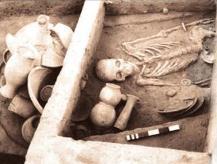Source - http://timesofindia.indiatimes.com/city/chandigarh/Haryana-Harappans-had-stainless-smile-ASI/articleshow/46994080.cms

It is hard to believe villagers in Haryana, known for their hookah and beedi consumption, had maintained excellent dental hygiene and adopted sophisticated food preparation methods around 5500 years ago.
But Archaeology Survey of India's (ASI) excavation at Haryana's Rakhigarhi site - which is now feted as the biggest Harappan site with 350 hectares - has found good dental hygiene in the dozen skeletons it dug up between 1997 and 2009.
"Dental health of the skeletons is good. Calculus formation is common but caries are less in frequency. There is not much of antemortem (after death) tooth loss," said the ASI report submitted to the Union culture ministry in December 2014.
Pointing out non-eruption of the third molar (popularly known as wisdom tooth) in the skeletons, the report has attributed this to "sophisticated food preparation methods that resulted in reduction of masticatory stress".
The biological anthropology for the ASI report was done by Dr S R Walimbe in 2011.
According to the report, the Harappans at Rakhigarhi mainly ate wheat, barley and bathua (a leafy vegetable like spinach).
The report also said that residents of Rakhigarhi relied heavily on dairy products which included curd and milk. "Excavations have recovered a high percentage of buffalo bones from all occupation levels," it said.
Of the 23 sites, within 15km radius where the excavations were done, the report said farming activity was restricted to 4-5km area at four places which are now referred as Gamra, Budana, Haibatpur and Lohari Ragho 3.
The report added that 10 out 12 skeletons had all 32 teeth intact, pointing to extreme robusticity of glabellar region (the area between eyebrows and nose).
According to a study, hookah smokers in Haryana villages consume on an average 50-100g tobacco mixture per day. Smoking hookah can affect the dental hygiene and cause gum diseases.